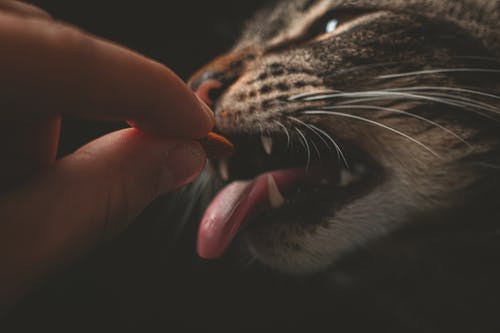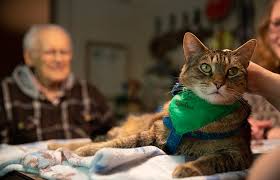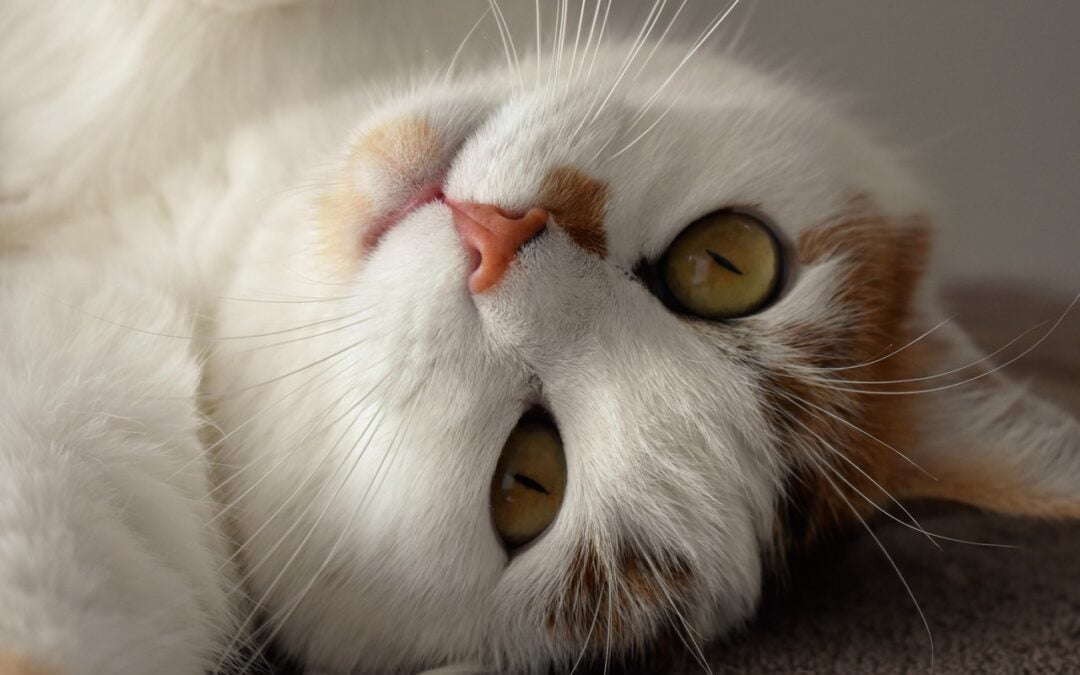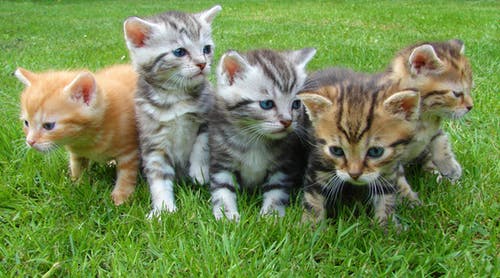
by Margejane | Cat Health, Featured, Uncategorized
Do you have a feline pet? Has your cat suffered any infectious disease so serious that you thought you were going to lose your four-legged friend? Well, I have and it was definitely an experience to remember. Thanks to an amazing “magical product” from Chewy, my sweet little kitten – Lucy, is still playing around the house and even eating more than ever.
It was on one sunny afternoon in January that I first noticed the presence of a black ‘tarry’ appearance in Lucy’s stool – little did I know it was digested blood then. At first, I ignored that but then I started to notice other unusual symptoms like weight loss and poor hair coat. Then the next symptom – anemia – proved it right that something was definitely wrong with my cat. My cat was also starting to experience itching, especially in her paws, and skin irritation.
I began to panic and quickly placed a call through to my veterinarian and booked an appointment for my kitten.
Does my pet have a feline hookworm infection?
The next morning, I was at the vet clinic with my cat. The vet diagnosed her with hookworm infection through a technique called fecal flotation. He mixed a little amount of my cat’s stool in a special solution, which made the hookworm eggs float atop the solution and stick to a glass slide that had been placed over the top of the solution. Due to the unique appearance of the eggs, the vet could easily identify them under a microscope. “So what’s the way out?” I asked the vet. And he prescribed a simple, safe, and quite inexpensive medication for her treatment: Revolution Topical Solution! I was skeptical at first, especially because I had not purchased a product from Chewy prior to then. I decided to give the anthemic drug a try and after using this deworming medication, all adult hookworms in my cat were killed.
The vet administered a minimum of two treatments, given at 2-3 week intervals, for effective treatment. This helped to kill adults that matured after the first treatment.
With good diagnosis and treatment using Revolution, the prognosis was incredible for a complete recovery from hookworm infection.

How did I treat her?
Revolution Topical Solution for Cats (5.1-15 lbs, (Blue Box), 6 Doses (6-mos. supply) is a medication that is applied directly to the skin of your furry friend in order to protect your precious pets from biting critters. When applied once every month, Revolution may be effective in the prevention and treatment of hookworms, roundworms, and ear mites. It is equally an excellent solution for protection against fleas and heartworms.
Before commencing this medication, discuss with your veterinarian any other medications your cat is using. It is noteworthy to state that Revolution is not effective against adult D. immitis. This drug should be kept out of reach of children and should be used in animals only!
Pros Of Revolution Topical Solution for Cats
- Revolution terminates adult fleas and prevents the hatching of flea eggs for one month.
- It has also been indicated to help prevent and control flea infestations.
- It is effective in the prevention of heartworm disease caused by Dirofilaria immitis
- It can be used to treat and control ear mite infestations
- Last but not least, it is an excellent medication for the treatment and control of intestinal hookworm and roundworm infections in cats.
Cons Of Revolution Topical Solution for Cats
There are only two indicated possible side effects of Revolution:
- Salivation and;
- Intermittent vomiting
Comparisons between Revolution Topical Solution and other related products
Unlike most other anthelmintics, Revolution Topical Solution kills the larval stages. Most other drugs are ineffective in terminating the larval stage and this could result in poorer prognosis and extensive treatments for the kittens or cats.
Additional to that, Revolution works as a heartworm preventive drug while also preventing hookworm infection and several other diseases. Other similar medications do not have this multiple treatment functionality.
Also, Revolution is relatively more affordable than other related products. It costs only $130.05 for a box of 6 doses. It is pretty inexpensive for a quality medication that offers a lot for your cat.
Conclusion
Revolution Topical Solution is a veterinarian-approved parasite prevention product. It is a trusted medication for any of the cat issues mentioned above. I’ve recommended this medication to family and friends who experienced the same or similar conditions with their pets, and they always return with positive remarks and words of appreciation. You can get this product on Chewy and watch your furry friend bounce back with vitality and energy.
P.S: Lucy sends her greetings!

by Margejane | Cat Health, Featured
Hypertension can cause damage to the internal organs of our pet, with hardly any symptoms. That is why it is important to know what it is and, above all, how to identify and act on high blood pressure in cats.
How pressure measured and what is considered abnormal blood pressure in a cat?
First of all, we must know that it is possible and important to measure feline blood pressure. Taking a measurement is not as easy in veterinary medicine as in human. In felines, it is more difficult to do so due to the arrangement of their organs and the low intensity of their pulse wave.
There are invasive methods and non-invasive methods for taking blood pressure. The latter, which are easier to use, offer reliable measurement values. Our veterinary team, through a Doppler or the oscillometric or photoplestimographic method, will be able to obtain in a visit the blood pressure values of our cat and detect any anomaly.
It is recommended to take between five and seven readings (with a variability of 20%) to obtain reliable values.
Mean, systolic, and diastolic blood pressure in cats
Blood pressure is the value of the force of the blood when it is pushed against the walls of the arteries by the beat of the heart, which pumps it through the circulatory system. The stronger the heartbeats, the higher the pressure. We call the blood pressure produced when the heart pumps blood, systolic pressure (SBP).
When our cat is at rest and the heartbeat is slower, blood pressure (BP) drops. This is the diastolic blood pressure (DBP).
When taking a reading of our cat’s blood pressure we use these two values (SBP and DBP) and, using a formula, we obtain the mean arterial pressure (MAP). This value will always be closer to the diastolic blood pressure.
Generally, the systolic value (SBP) is placed before the diastolic value (DBP). Thus, 120/80 will be interpreted as a systolic pressure of 120 and a diastolic pressure of 80.
Feline blood pressure
- Normal-pressure in cats not under sedation should be:
- Between 120 and 180 mmHg of systolic blood pressure(SBP).
- Between 100 and 150 mmHg mean arterial pressure(MAP).
- Between 60 and 100 mmHg of diastolic blood pressure(DBP).
- Values greater than 160 mmHg of SBP and/or 100 mmHg of DBP(obtained in repeated measurements, obviously always correctly) can be considered arterial hypertension (HTN).
- PAS values above 180 mmHg are considered severe hypertension and will require immediate evaluation and treatment.
What Causes Feline Hypertension?
The high voltage cat usually occurs because of another disease that affects the health of the cat. The most common cause of hypertension is a sedentary lifestyle and being overweight in our pets. Older animals are more prone to hypertension, so their examination protocol should include systematic blood pressure measurement.
Also, depending on the origin of the cat’s hypertension, we can divide hypertension into three types:
- Primary (or idiopathic) hypertension: it is not usually related to the presence of other diseases. Its cause is not specifically known; therefore, it is related to the genetics of the animal. It is estimated that between 13% and 20% of hypertensive cats suffer from idiopathic hypertension.
- Secondary hypertension: the blood pressure problem is due to another disease, such as diabetes or kidney damage.
In addition to primary or secondary hypertension, episodes of occasionally high blood pressure can also occur, due to moments of fear or stress/excitement of the cat (such as that which can occur during a visit to the veterinarian). Punctual high pressure should not be considered hypertension as such, since it will not last over time and will not necessarily have negative effects.
Dangerous effects of hypertension in cats
The pressure in cats can be very dangerous because of the effects that can cause organs this health problem.
In the eyes
The high voltage in cats can cause intraocular hemorrhage, detachment or retinal swelling, and even loss of vision, usually unrecoverable.
In the brain and nervous system
The pressure in cats can cause problems in the neurological system of the animal. Therefore, the feline will have strange behaviors, wobbly when walking, and can suffer dementia, seizures, and even go into a coma.
In the heart
When there is hypertension, it is harder for the heart to pump blood, especially affecting the left ventricle. One of the effects of severe systematic arterial hypertension in cats is congestive heart failure, which manifests itself in our pet in lethargy (decrease its activity and increase its drowsiness) and respiratory problems.
In the kidneys
Chronic renal failure is the most common condition associated with cats with high blood pressure. In addition, as we have seen before, it is very common for cats that suffer from this kidney problem to have hypertension.
How to know if a cat suffers from hypertension?
As we have explained previously, Hypertension, generally, usually manifests as a consequence of another underlying disease. Therefore, affected patients are likely to have symptoms associated with the underlying disease. On many occasions, the owners go to the vet when the symptoms are severe and there is, for example, sudden blindness or eye bleeding.
Early diagnosis will prevent organ damage. Therefore, it is essential that, at the slightest symptom, you go to an emergency veterinarian.
What are the main symptoms?
This is a list of the symptoms associated with hypertension that should put us on alert:
- Litter box rejection.
- Hyperactivity and nervousness.
- Changes in basic behaviors: defecations in strange places and blood in the urine.
- Sadness and apathy.
- Nasal bleeding.
- The cat hides.
- Sudden loss of weight and appetite.
- Blindness, either temporary or permanent.
- Hemorrhage of the eyeball and dilation of the pupils.
- Strange and constant movements of the eye.
- Temporary paralysis of the extremities.
- Heart disease and seizures.
- Enlargement of the kidneys.
In the most severe cases, the minnow may show hypersensitivity to light and movement problems. In addition, it can be difficult for you to coordinate movements and suffer from disorientation.
Can feline hypertension be treated or prevented?
As with people, prevention is the best treatment to avoid high blood pressure in cats. The most advisable thing is to make periodic visits to the vet to monitor the health of our pet and measure its blood pressure periodically.
- In healthy cats from 3 to 6 years of age, itis recommended measuring blood pressure every 12 months.
- In healthy senior cats 7 to 10 years of age, itis necessary to measure blood pressure at least every 12 months.
- In healthy geriatric cats from 11 years of age, the measurement is necessary every 6 – 12 months at the most.
- In any cat with risk factors such as hyperthyroidism, kidney failure, etc. … the measurement is recommended every 3 – 6 months.
Hypertension cannot be avoided 100%, but an active and healthy life is the best method to prevent it. In cats, in addition, a calm environment, good nutrition, and environmental stimulation and play will help our cat to be strong and healthy.
Once you notice your cat suffers from this, the most important thing is to know if hypertension occurs as a cause of secondary disease or if it is of a primary type. To do this, it is best to go to a specialist who can help.
We should suspect hypertension in any feline with chronic kidney failure, heart disease, or hyperthyroidism. Therefore, if another disease has caused hypertension, the origin must first be resolved.
Prognosis of the cat with hypertension
The prognosis depends on the type of hypertension of the animal and how it has affected it.
When we talk about primary hypertension (that is, there is no underlying disease that causes high blood pressure) it is likely that we can achieve adequate control of hypertension and avoid complications, such as eye damage and that the problems do not go further.
Normally, cats with hypertension and blindness can live, thanks to antihypertensive treatment, for several years with a good quality of life.
If the hypertension is secondary, the prognosis will depend on the severity of the disease-causing high blood pressure. Cats suffering from chronic kidney failure and suffering from hypertension tend to have a worse prognosis than those with a condition such as hyperthyroidism, which is treatable.
In any case, if our cat is diagnosed with Hypertension, the most important thing is to perform periodic blood pressure measurements to prevent severe damage to the eyes, nervous system, kidneys… and to identify and treat the disease that causes it, if hypertension is secondary type.

by Margejane | Cat Health, Featured
Feline pancreatitis is a disease that frequently affects cats, but can often go unnoticed. This happens because it usually occurs progressively, giving non-specific symptoms common to other diseases such as weight loss or lack of activity.
However, feline pancreatitis can also appear suddenly with very severe symptoms and jeopardize the life of our cat. Therefore, it is important to know how to identify it in order to act as soon as possible if it develops. Next, we talk about feline pancreatitis, its symptoms, and its treatment.
What is feline pancreatitis?
Pancreatitis is an inflammatory disease of the pancreas that can affect cats of any age, breed, or sex.
The pancreas is an organ that is part of the digestive system and is close to the liver, leading to the small intestine through the common bile duct. It has an endocrine function (secretes insulin) and an exocrine part (produces digestive enzymes that go to the intestine to digest fats, proteins and carbohydrates).
There are two types of pancreatitis in cats, acute and chronic, depending on whether it occurs suddenly or is recurrent over time; being the chronic manifestation the most common in cats. In general, acute pancreatitis is a severe process and has a high mortality, while in the chronic form, the symptoms are moderate.
How is feline pancreatitis diagnosed?
Symptoms of pancreatitis are very nonspecific, but this disease should be suspected in animals with anorexia, lethargy, or vomiting of unknown cause.
Several tests must be combined for diagnosis:
- Laboratory tests: blood tests and specific tests like fPLI.
- Imaging diagnosis: ultrasound and/or radiography.
The definitive diagnosis that confirms that it is really treated is pancreatitis and determines the type, is the biopsy. However, this diagnosis requires general anesthesia and surgery to take the tissue sample and is only done in cases strictly necessary to avoid risks.
Treatment for pancreatitis
The treatment of feline pancreatitis depends on the severity of the process and can range from the simple administration of analgesics for pain and a specific diet in cases of mild chronic pancreatitis, to intensive care with emergency hospitalization in the most acute cases.
Treatment is supportive and is based on:
- Pain control with analgesics.
- Fluid therapy to rehydrate.
- Control of nausea and vomiting with antiemetics.
- Antibiotic therapy when necessary.
- Nutritional management: the cat should eat again as soon as possible and, if it does not eat by itself after a few days, a forced feeding protocol will be started (feeding tubes or total parenteral nutrition).
- Maintenance of body temperature in cats with hypothermia (it should always be kept above 37ºC).
- Stress- free environment.
Forecast
The prognosis for cats with pancreatitis varies depending on the general condition of the animal and the severity of the presentation of the disease.
If the cat shows mild symptoms, it is more likely to respond adequately to supportive treatment and recover. However, there are no guarantees that the process can be re-produced; inflammation of the pancreas can become chronic in certain cats.
When the cat develops severe symptoms (shock, hypothermia, low blood glucose levels, or even kidney failure) and its condition is critical, the cat requires hospitalization and prolonged therapy, in these cases mortality being high.
If the pancreatitis is severe or becomes chronic, the cat can develop secondary pathologies such as diabetes mellitus or exocrine pancreatic insufficiency, because the functionality of the pancreas can be lost if there are a significant number of cells damaged by inflammation or fibrosis with the progression of the disease.
As we can see, feline pancreatitis can become a very serious disease that begins with apparently mild symptoms, so in the event of any suspicion of being unwell in our cat (loss of appetite, that is down or vomiting occurs), we should not wait and it is recommended to go to the vet as soon as possible.

by Margejane | Cat Health, Featured
There is increasing awareness and knowledge about why and how to take care of our furry friends. Thus, we have managed to extend their life expectancy, which is around 20 years on average. This brings with it an increase in cases of senile dementia. In fact, Alzheimers in cats does not stop growing among the senior cats.
It affects 30% of 11-year-old cats and more than 50% of those over 15 years of age. In veterinary slang, senile dementia in cats is called Cognitive Dysfunction Syndrome (CDS). Although there is no cure, its treatment slows its progress and alleviates the symptoms. Do you want to know more about this incurable pathology?
More than just age-related decline
CDS constitutes a progressive degeneration of the central nervous system more severe than that caused by aging. Neurological injuries damage the cat’s perception, consciousness, learning and memory, and reduced vitality and quality of life. They begin to forget established routines and become overwhelmed, for example, by visits.
The symptoms of Alzheimer’s in cats are very varied and not all kittens manifest them in their entirety. However, disorientation, loss of interest in grooming, persistent meowing at night, and disturbed sleep patterns are unmistakable signs of feline senile dementia.
Take note of the symptoms:
- The cat is stunned, with an absent gaze, it gets lost at home and wanders without knowing where it is and what to do.
- Cats sleep more during the day and little at night. The nightly meows claim your attention because they don’t want to be alone.
- The cat starts having accidents and do not remember where the litter tray is or how to access it.
- He becomes more apathetic, no longer jumping to his favorite corners in the heights. It is especially striking in very active races such as the Sphinx.
- Eat and groom less.
- The kitty doesn’t remember routines learned in the past.
- The kitty feel anxious, aggressive or the need to flee from changes.
- He is irascible for no apparent reason or refuses your caresses when he did not before.
The influence of medical conditions
As we say, behavioral changes are part of the symptomatology of cognitive dysfunction. However, these changes may be due to pathologies derived from aging or latent conditions years ago. Therefore, to determine with certainty that it is senile dementia you should consult with your vet.
The diseases that we refer to as causing behavioral alterations that we could confuse with those of cognitive dysfunction are the following:
- Hyperthyroidism
- Diabetes
- Osteoarthritis
- Hypertension
- Chronic renal insufficiency
- Infections
- Dental, ophthalmological or hearing diseases
- Gastrointestinal conditions
Is it possible to prevent Alzheimer’s in cats?
The answer is a resounding no. Unfortunately, there is no scientific evidence that confirms the possibility of preventing a neurological condition as severe and irreversible as this one. However, offering them a diet rich in antioxidants, as well as daily mental stimulation, is a highly recommended tactic to minimize their presence.
Hunting games, interactive toys and social interactions are a simple, but effective, methods against any condition of a cognitive type. In turn, remember that the emotional and physical dimensions are closely related to the cognitive, so that exercise will always benefit the cat’s health in a holistic way.
Treatment for Alzheimer’s in cats
Cognitive Dysfunction Syndrome is a disease without a cure and, therefore, its treatment only aims to slow its progress and provide quality of life to the animal by alleviating the intensity of the symptoms. Although there is pharmacotherapy, consisting of the administration of selegiline-based drugs, treatment is domestic.
In other words, if you live with a kitten suffering from senile dementia, you will have to accommodate your home by facilitating access, reducing changes at home to a minimum, modifying its diet and taking care of its hygiene. You must place access ramps to the sandbox and mark where the feeder and the drinker are.
It is not advisable to alter the location of their belongings, since senile cats do not tolerate changes and this overstimulation could aggravate their symptoms. If the changes are relevant, you should carry them out gradually. Likewise, you need to prepare a quiet room just for him where he can rest and be relaxed.
Cat play with Alzheimers
Despite the fact that it may seem contradictory due to the lack of interest of the kittens in these conditions for play and interaction, it has been found that playful sessions greatly benefit these animals. The key is to increase the frequency and reduce the duration of the same.
As you can see, Alzheimer’s in cats is not very different, in terms of its symptoms and treatment, from that of humans. Undoubtedly, maintaining close contact with your veterinarian and striving to be more patient and affectionate, if possible, with him will make a difference in the well-being that he enjoys in the final stage of his life.

by Margejane | Cat Health, Featured
The eyes are very sensitive organs in our cats, so we must be attentive to any sign that indicates that something is wrong. Not receiving treatment can cause the cat to lose vision and even the eye.
These are the most common diseases in cats, those they can acquire and even transmit to a human and their respective treatments.
Conjunctivitis in felines
Conjunctivitis is a very common disease that consists of inflammation of the conjunctiva, which is the area that covers the eye. It can have different causes, for example, a foreign body that gets into the eye. In this case, the symptoms will be unilateral.
But it is more common for conjunctivitis to occur in young cats and in communities due to an infection such as that caused by herpesvirus. Cats that have overcome this infection can relapse in times of stress.
Symptoms include:
- Yellowish and abundant discharge. If we do not clean it, when it dries on the eyelids it forms crusts that will keep them glued. – Redness.
- Photophobia, the cat is bothered by light and keeps the eye closed as much as possible.
- The most common is that it occurs in both eyes.
- In addition, in conjunctivitis caused by herpes virus, we will observe respiratory symptoms, with nasal discharge, fever, cough, anorexia, etc.
These cases are very contagious, so it is very important to go to the vet at the first symptom to quickly control the spread of the virus and, in addition, prevent the eye infection from ending up perforating the cornea, causing blindness.
It is treated with topical antibiotics in the form of eye drops or ointment. It is very important that before applying any medication we clean the eye well. We can do it with a cotton ball or gauze soaked in warm water or serum. We will pass it from the inside to the outside of the eye to remove scabs and secretions. A different gauze is used for each eye.

Dendritic ulcers in cats
Ulcers are wounds that occur in the cornea, which is the surface layer of the eye. They can be due to trauma, scratches, foreign bodies, or viral infections. It is very common that they occur as a complication of rhinotracheitis caused by herpesvirus.
Rhinotracheitis is a viral disease that causes respiratory symptoms characterized by abundant nasal and ocular discharge, cough, anorexia, dehydration, fever, etc. The effect of the virus on the eyes causes the characteristic dendritic lesions, due to their structure similar to the dendrites of neurons.
It is common in cats that live in colonies on the street because they are the ones that suffer the most from the virus. Rhinotracheitis is very contagious, so it spreads easily among unvaccinated and more vulnerable cats such as the young, old, sick, or poorly nourished.
Herpesvirus is capable of causing ulcers of a certain depth that, if left untreated, end up perforating the cornea. The cat will go blind and the eye may eventually prolapse, necessitating its removal. This can happen in one or both eyes.
Sometimes we can observe this type of ulcer in healthy cats that have had rhinotracheitis, becoming carriers of the virus. The veterinarian is the one who must assess the severity of the injury and decide the treatment. Ulcers are painful, therefore, and due to the complications that it can cause, we should not leave them unattended.
Uveitis in kittens
It is a relatively common eye disease in which inflammation of the uvea occurs, which is a structure that surrounds the inside of the eyeball. It is important to treat it to avoid further damage, but also because it is a symptom that can appear in serious diseases such as the following:
- Toxoplasmosis.
- Feline leukemia.
- Immunodeficiency.
- Feline infectious peritonitis (FIP).
- Bartonellosis.
- Fungal diseases
- Herpesvirus.
Furthermore, uveitis can be associated with trauma. Various degrees of severity are distinguished depending on the structures that are affected. Thus, we speak of anterior, intermediate, or posterior uveitis.
The symptoms that alert us to the appearance of uveitis are:
- Pain.
- Photophobia.
- Profuse tearing
- The eye conveys the sensation of being smaller and softer to the touch.
- Visualization of the third eyelid, a protective ocular structure in the lower margin of the eye that is not appreciated under normal conditions.
The treatment is based on the identification of its cause essential to guide the veterinary interventions necessary to solve it. In addition, given the severity of some of them, it is important to go to the clinic immediately.
Glaucoma in Cats
This disorder in the eye is due to an increase in intraocular pressure, which can have different causes. Aqueous humor is produced in greater quantity than is eliminated, thus causing an increase in pressure.
It is a veterinary emergency because the process that is triggered is capable of damaging the optic nerve and that is a cause of blindness. It affects older cats, often associated with other pathologies such as tumors, uveitis, or trauma.
Any symptoms of eye injury should make us go to the vet because in cases such as glaucoma if we wait to see the enlarged eye or the dilated pupil we may already be too late to avoid blindness.
The diagnosis is easily confirmed by measuring intraocular pressure. It may be more complicated to diagnose the cause. It is essential to medicate to return the pressure to normal values and control the pain.

by Margejane | Cat Health, Featured
FIP, feline infectious peritonitis (FCoV) is a virus of the gastrointestinal tract. The majority of infections are either asymptomatic (no symptoms) for months or even years, or cause diarrhea.
This is very common in kittens whose maternally derived antibody decreases between 5 and 7 weeks old. The majority of cases are most prevalent in cats younger than 3 years old, and especially in kittens 4 to 16 months old.
The virus is most common where there are large groups of cats living in the same house sharing food and water dishes. Using contaminated litter scoops can transmit infected microscopic cat litter particles to uninfected cats and kittens.
Other means of ingesting or transmitting FCoV is inhaling the virus when it is shed in feces, which happens when litter boxes are shared. Another method of transmission is through different body fluids, easily spread by direct contact between cats, most commonly when an infected cat grooms an uninfected cat and the infected saliva remains on the uninfected cat. When the healthy cat grooms himself he will ingest the virus.
There are 2 types of FIP:
- Effusive (wet) FIP – the clinical sign of effusive FIP is fluid accumulating in the chest or abdomen. This can cause breathing difficulties. The cat may also experience loss of appetite, fever, diarrhea, jaundice and weight loss.
- Non-effusive (dry) FIP – Symptoms of dry FIP are the same as with wet FIP, but there is no fluid accumulation. The cat may have difficulty standing up or walking, eventually becoming paralyzed. Blindness may also occur.
Your veterinarian has multiple tests to determine if your cat is suffering from a form of FIP.
While FIP is considered fatal, there are antiviral drugs that have proven promising, such as experimental drugs, GS-441524, and GC376. As of this writing, these drugs were not yet commercially available.
Felocell is an intranasal vaccine for healthy cats 16 weeks and older to help prevent cats from contracting FIP. It is available in the U.S.









Recent Comments